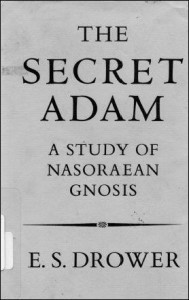
The Secret Adam – a Study of Nasoreaen Gnosis by E. S. Drower takes us deep into the pre-Christian spirituality of the ancient Persia. Still today there are remnants of the Mandaeans (“Gnostics“) also known as Sabaeans in Iraq who among others had a tradition of baptism. Their knowledge is historically accessible through a vast amount of scrolls. In The Secret Adam, E. S. Drower outlines the history of the people, their thoughts and secret knowledge.
Download it here:
The Secret Adam – A Study of Nasoraen Gnosis
Who where The Mandaeans?
The Mandaeans are a religious community practicing Mandaeism, one of the lesser-known ancient Gnostic religions. Their traditions have roots that trace back to the early centuries AD, possibly earlier, and they hold beliefs that are distinct from the major religions of the region.
Key aspects of Mandaean beliefs and practices include:
- John the Baptist: Unlike Christian tradition, which views John the Baptist as a prophet who paved the way for Jesus Christ, the Mandaeans consider John the Baptist as their main prophet and reject Jesus’s divinity and messiahship. They have their own writings about John’s teachings, separate from the Christian Gospels.
- Gnosticism: Mandaeism holds a dualistic view of the world, typical of Gnostic systems, wherein the physical universe is a creation of a lesser god, distinct from the true, higher God. The human soul, inherently divine, is considered trapped within the body and the material world. Salvation involves gaining secret knowledge (‘gnosis’) about humanity’s divine origin, which offers escape from the physical world’s limitations.
- Rituals and Practices: The religion places a heavy emphasis on rituals, the most significant of which is baptism (or ‘masbuta’), which isn’t just a one-time ceremony but a regular practice that reaffirms their purification and commitment to their faith. These baptismal rites typically occur in flowing water, symbolizing the soul’s purification and return to its divine origins.
- Holy Writings: Their religious literature includes the “Ginza Rba” or “Great Treasury,” a collection of theological texts and prayers, and the “Book of John” or “Drasha D-Yahia,” detailing the stories and teachings of John the Baptist.
- Current Demographics: Historically, the Mandaeans were largely found in the region of what is now southern Iraq and Iran, particularly in the area around the lower Karun, Euphrates, and Tigris rivers. Conflicts in the Middle East, particularly since the early 21st century, have led to the displacement of many Mandaeans, with communities now found in diaspora locations like Europe, Australia, and the United States. These migrations have threatened the continuation of some of their traditional practices, which rely heavily on community involvement and specific geographic and environmental features.
Throughout history, the Mandaeans have faced significant persecution, and their communities often struggle with issues of survival and preservation of identity, particularly in the face of modern geopolitical challenges. Despite these pressures, they continue to practice their religion, holding onto a unique spiritual tradition that spans millennia.

